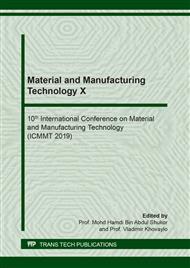[1]
M. Domingo, J.M. Puigriol, A.A. Garcia, J. Lluma, S. Borros, G. Reyes, Mechanical property characterization and simulation of fused deposition modeling polycarbonate parts, Mater. Des. 83 (2015) 670–677.
DOI: 10.1016/j.matdes.2015.06.074
Google Scholar
[2]
J.M. Chacon, J.C. Bellido, A. Donoso, Integration of topology optimized designs into CAD/CAM via an IGES translator, Struct. Multidiscip. Optim. 50 (2014) 1115–1125.
DOI: 10.1007/s00158-014-1099-6
Google Scholar
[3]
M. Kamran, A. Saxena, A Comprehensive Study on 3D Printing Technology, MIT International Journal of Mechanical Engineering, Vol. 6, No. 2, August 2016, pp.63-69.
Google Scholar
[4]
C. Casavola, A. Cazzato, V. Moramarco, C. Pappalettere, Orthotropic mechanical properties of fused deposition modelling parts described by classical laminate theory, Mater. Des. 90 (2016) 453–458.
DOI: 10.1016/j.matdes.2015.11.009
Google Scholar
[5]
J. Kotlinski, Mechanical properties of commercial rapid prototyping materials, Rapid Prototyping Journal 20 (2014) 499–510.
DOI: 10.1108/rpj-06-2012-0052
Google Scholar
[6]
A. K. Sood, R.K. Ohdar, S.S. Mahapatra, Parametric appraisal of mechanical property of fused deposition modelling processed parts, Mater. Des. 31 (2010) 287–295.
DOI: 10.1016/j.matdes.2009.06.016
Google Scholar
[7]
B.M. Tymrak, M. Kreiger, J.M. Pearce, Mechanical properties of components fabricated with open-source 3D printers under realistic environmental conditions, Mater. Des. 58 (2014) 242–246.
DOI: 10.1016/j.matdes.2014.02.038
Google Scholar
[8]
J.F. Rodriguez, J.P. Thomas, J.E. Renaud, Mechanical behavior of acrylonitrile butadiene styrene ABS fused deposition materials. Experimental investigation, Rapid Prototyping Journal 7 (2001) 148–158.
DOI: 10.1108/13552540110395547
Google Scholar
[9]
J.F. Rodriguez, J.P. Thomas, J.E. Renaud, Design of fused-deposition ABS components for stiffness and strength, J. Mech. Des. 125 (2003) 545–551.
DOI: 10.1115/1.1582499
Google Scholar
[10]
R. Zou, Y. Xia, S. Liu, P. Hu, W. Hou, Q. Hu, C. Shan, Isotropic and anisotropic elasticity and yielding of 3D printed material, Composites Part B 99 (2016) 506–513.
DOI: 10.1016/j.compositesb.2016.06.009
Google Scholar
[11]
O. Avinc, A. Khoddami, OVERVIEW OF POLY(LACTIC ACID) (PLA) FIBRE, Part I: Production, Properties, Performance, Environmental Impact, and End-use Applications of Poly(lactic acid) Fibres, Fibre Chemistry, Vol. 41, No. 6, (2009).
DOI: 10.1007/s10692-010-9213-z
Google Scholar
[12]
D638, ASTM Standard test method for tensile properties of plastics, Annual Book of ASTM Standards 10 (2010) 1–16.
Google Scholar
[13]
A. Almajid, K. Friedrich, J. Floeck, T. Burkhart, Surface Damage Characteristics and Specific Wear Rates of a New Continuous Carbon Fiber (CF) /Polyetheretherketone (PEEK) Composite under Sliding and Rolling Contact Conditions, Appl Compos Mater (2011) 18:211–230.
DOI: 10.1007/s10443-010-9147-x
Google Scholar


